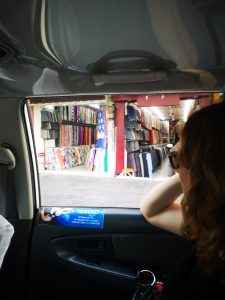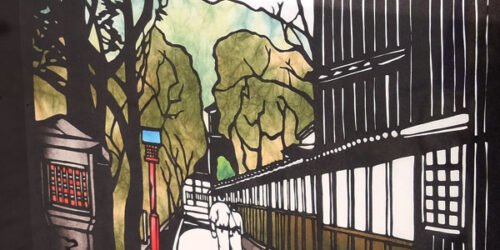
Suzanne Joinson is an award-winning writer of fiction and non-fiction whose work has appeared in, among other places, the New York Times, Vogue UK, Aeon, Lonely Planet collections of travel writing and the Independent on Sunday.
Suzanne will be leading a two-workshop series on travel writing with Agustinus Wibowo. The first workshop, titled ‘Travel writing: journeys of the imagination’ takes place on Thursday 22 August. Find out more >>
I used to be an obnoxious traveller, the sort to mutter, ‘You can’t begin to understand a desert landscape until you’ve heard the Tuareg playing in the Sahara.’ I believed that only exotic and faraway places really counted as Travel with a capital T. I drifted through the marketplaces of Sana’a in Yemen. I swirled tea around my cups like the locals do in Kashgar, Xinjiang Province. I ate snake in Myanmar. Nibbled cakes in St Petersburg. Rode horseback in Patagonia. Ice-skated in Siberia. I was fond of swanning about in scarves and djellabas and wore flip-flops made from beads from the South Pacific Islands.
On board a plane, I was reading an inflight magazine about a city called Tromsø, the most Northern city in the Arctic. The picture of the light and sky made me want to go there so deeply it felt like a physical ache, but I was flying in the opposite direction. I was heading South, to a small island in the Mediterranean and a powerful sense of claustrophobia came over me: I was going the wrong way! This conviction quickly spiralled into: I was living the wrong life. I was doing everything badly. I needed to change. Panic.
What was this endless, jittery compulsion to flit and fly?
When I arrived at Valletta airport I didn’t even leave the building. I bought a coffee and sat with my phone searching Airbnbs and flights to Tromsø. After an hour, I looked up and stretched my spine. I blinked. A Maltese lady walked past me wiping her mop on the shiny floor. It looked clean enough to me. She was humming and I thought: what was I doing? What was this endless, jittery compulsion to flit and fly? Was it a fear of missing out, or a need to keep running? Why did I want to leave as soon as I arrived?
 I put my phone away and stepped out of the transit-nowhere-land of the airport into the Mediterranean sun. That evening I ate spaghetti alle vongale alone in a restaurant on the edge of a harbour that dated back to the fifteenth century. I drank a glass of cold white wine and breathed. The fishermen hauling in their nets laughed and smoked and I noticed that the boats all had blue eyes painted on their helm.
I put my phone away and stepped out of the transit-nowhere-land of the airport into the Mediterranean sun. That evening I ate spaghetti alle vongale alone in a restaurant on the edge of a harbour that dated back to the fifteenth century. I drank a glass of cold white wine and breathed. The fishermen hauling in their nets laughed and smoked and I noticed that the boats all had blue eyes painted on their helm.
One of the fishermen called something out at me, friendly, and though I hadn’t heard what he’d said, I smiled back and waved. Travel doesn’t have to be about the distancing of self from the familiar and the home. It’s not really about the airmiles between this place and that. As I sat there it occurred to me that, really, it’s about intimacy.
An intimate journey is one that is taken closely, privately, either with companions or full of encounters or alone. It’s an idiosyncratic response to a place. This private, personal feeling in response to an environment contains both the real – smells, food, weather – and imaginary zones. In my case, there was also a certain amount of literary-ghost chasing. Moments of pretending to be Agatha Christie in her hotel room in the Pera in Istanbul or channelling Graham Greene in the Hotel Continental in Ho Chi Minh City.
When you move around and look properly you start to see that stories are everywhere
Travel is a bridge that links mental, emotional and real maps into a vivid, personalised web. When you move around and look properly you start to see that stories are everywhere: the woman leaning out of the window and staring into the sun for a second before slamming a blind shut. The sound of giggles coming from a track leading off a beach. Mysterious clapping from deep inside a taverna.
Travel is being in a particular moment of time, in a distinct latitude, and having our ever-evolving narrative enriched by this experience. As I finished my spaghetti I felt the exact moment of being at this harbour crystalize into a memory in real-time as it happened. No big deal, just a meal one evening, but also magical time-travel. A spooky transference from the real to the remembered.
I sat back, enjoyed my wine, and vowed to stop rushing around the globe at such a rate (and also to stop buying scarves and flip-flops). I decided to slow down, take a moment, and most importantly, look. When this was done, I did of course book a flight to Tromsø. I was just in less of a hurry to get there.
Travel writing tips:
- Write on the go, write up your piece while you are still there and edit as soon as you can when you get home. Don’t leave it too long. Use a notebook, your phone and the app evernote is very good because you can collate audio, pics and text on notes and share across devices.
- Write in first person, past tense, on the whole. Or present tense if it works with the anecdote or story that opens up the piece. Use a story to draw the reader in before downloading the facts.
- Find specific details that convey the atmosphere and feeling of a place and tie them to a wider narrative than simply ‘I went to … I came back’. Readers are always looking for a wider context to off-set the personal story.







